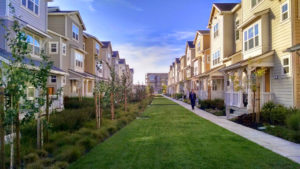On February 20th, Smart Growth California hosted a video conference for funders to learn about the package of housing bills passed in 2017 with a focus on six bills including several with land use implications. In this blog, we summarize the highlights of the call.
A Historic Year for Housing Legislation
In 2017, the California State Legislature passed an unprecedented number of housing-related bills. What’s known as the “2017 housing package” included 15 bills, but an additional 25 smaller, more niche housin g bills were passed as well.
g bills were passed as well.
How did such a historic year for housing happen, especially since advocates had been working tirelessly to pass many of the pieces of legislation in the housing package for years? Simply put, the entire state is in crisis.
“We are experiencing the greatest housing affordability and homelessness crisis in the history of our state,” said Lisa Hershey, Executive Director of Housing California, during our conversation. This crisis created a window of opportunity that would serve “as a launching point to scale our strategies for greatest impact,” says Hershey.
In other words, the affordable housing movement was ready to take advantage of the window of opportunity to advance policy, change the narrative around housing, and harness the power of multi-sector collaboration.
The housing package aims to address a range of issues. The California Department of Housing and Community Development states the four intentions of the package as: provide critical funding for new affordable homes; accelerate development to increase housing supply; hold cities/counties accountable for addressing housing needs in their communities; and create opportunities for new affordable homes and preserve existing affordable homes.
Though many advocates believe there is still much work to do on substandard housing and displacement issues, as well as addressing how Regional Housing Needs Assessment numbers are generated, nearly everyone agrees that this package is a major step forward.
Below are details on six of the housing bills, including opportunities for funders to make a difference.
SB 2 and 3 Seek to Address Funding Shortages
With the dissolution of Redevelopment Agencies across the state in 2012, California lost hundreds of millions of dollars annually for affordable housing construction. The legislature passed two bills – SB 2 and SB 3 – to help fill the funding void.
SB 2 (Atkins) created a permanent source of funding for affordable housing by imposing a $75 document recording fee on certain real estate transactions. Advocates had tried three times previously to pass similar legislation. Expected to raise $100 million a year, the monies will be distributed to local jurisdictions through the Community Development Block Grant formula, as well as used for farmworker housing and the California Housing Finance Agency, among other investments.
In the first year, however, 50% of monies from SB 2 will be passed through the California Department of Housing and Community Development to address homelessness. The other 50% will be used to support local jurisdictions in updating their local plans. This planning focus is significant given that cities often lack the capacity to execute their plans with proper community engagement. It will create opportunities for funders and their grantees to work with cities to shape and improve these plans for the best use of future monies coming down from the State.
The second major funding bill, SB 3 (Beall), places a $4 billion bond measure on the November 2018 ballot. If passed, the monies will be distributed to a variety of affordable housing programs, including generating a massive investment in housing for families and veterans. If passed, this bond would dwarf the last affordable housing bond measure passed, Proposition 1C (2006), which provided $1.5 billion for affordable housing.
Holding Cities Accountable to Housing Creation with AB 1397, SB 166, and SB 35
The housing package made important advances in strengthening the existing system of planning and zoning so that cities can be better held accountable to creating new housing through the passage of AB 1397, SB 166, and SB 35.
In our conversation, Anya Lawler, Policy Advocate with the Western Center on Law and Poverty, explained the State’s existing process for determining how much and which types of housing local jurisdictions must plan to accommodate.
It starts with the Regional Housing Needs Assessment (RHNA, pronounced ree-na) process, by which the state projects a region’s housing needs at four income levels: above moderate income (i.e., market rate), moderate income, low income, and very low income.
The council of governments (COG) then assigns a share of the need to every city and county within the region. Cities and counties must then create a “Housing Element”: an eight-year plan that, among other things, must show that the jurisdiction has enough available sites zoned for housing to accommodate their share of the RHNA. The law does not require local jurisdictions to actually build the housing, but recognizes the crucial role they play in setting the stage for housing development to happen through their planning and zoning powers.
Unfortunately, some cities have managed to undermine the intent of housing element law by including sites in their inventory that are not actually suitable for housing development, and particularly for multifamily development, which is crucial to producing affordable housing. Cities will sometimes identify sites that either too small or too large for multifamily development, or that having existing uses that are unlikely to cease operation during the housing element planning period, leaving sites that are more attractive to and usable by housing developers zoned for other uses.
An infamous example is the city of La Cañada Flintridge in Southern California, which allotted a substantial portion of its RHNA share for affordable housing to a lot that was occupied by a successful JOANN Fabric store. When community members expressed anger that the JOANN site was being rezoned for multifamily housing, the Mayor wrote an op-ed saying that the City did not actually think anyone would ever be able to develop the site as affordable housing and was only pursuing the rezoning to comply with the law—essentially checking a box rather than meaningfully creating opportunities for affordable housing development.
AB 1397 (Low) tightened up requirements for including a site in a housing element, ensuring it must be a real, developable, and adequate site for housing. In addition, SB 166 (Skinner) requires that cities must maintain adequate sites throughout the eight-year Housing Element planning period so that if a site is developed for another use, the city will have to find new sites to ensure there is an ongoing supply of sites available to accommodate the portion of the RHNA that has not yet been built.
When cities are not meeting their housing production goals, there is an additional piece of legislation designed to help: SB 35. SB 35 (Wiener) streamlines approval for multifamily infill projects on land that is zoned for housing if the project is consistent with that zoning and if the developer chooses to utilize the streamlined process. Streamlining is “turned on” in jurisdictions that are not permitting enough housing units to meet their RHNA goals. Streamlining is currently available for affordable housing projects in early every jurisdiction in the State, and is available for market-rate projects that set aside at least 10% of units for lower-income households in 70% of jurisdictions.
For SB 35 to achieve its goals of ensuring that projects proposed on sites zoned for housing get approved and speeding the production of housing, community members, advocates, and funders will need to continue to ensure that cities are playing by the rules – both old and new – and appropriately zoning developable sites for multi- family housing so that streamlining can be used by developers.
For example, a city could be underproducing affordable housing which means that streamlining is available for affordable projects. However, if the city hasn’t zoned any developable sites for multifamily housing, it will be impossible for affordable housing developers to benefit from SB 35. In short, SB 35 won’t be able to make a meaningful dent in the housing crisis without attention to the zoning needed for developers to utilize the law.
The interplay between SB 35, AB 1397, and SB 166 will also be critical. Funders should know that the amount of coordination and local action that will be required to harness these pieces of legislation is significant.
Inclusionary Housing Policies Are Fully Supported by AB 1505
For many housing advocates across the state, local inclusionary housing policies where a city requires of a percentage of new housing units to be protected as affordable has been an effective tool to ensure some amount of affordable housing creation.
For years, however, inclusionary housing policies have been hampered by a 2009 court decision known as “the Palmer decision,” which meant inclusionary ordinances could not be applied to rental housing developments – only for-sale units.
Attempts to overturn Palmer finally succeeded in 2017 with the passage of AB 1505 (Bloom), which restores the abilities of local jurisdictions to impose inclusionary requirements on rental housing.
Allowing inclusionary ordinances has great potential, though local advocacy and technical assistance are still needed to get them passed in cities that don’t have them and to ensure equitable implementation. One funder on the call shared the story of a city that has an inclusionary ordinance, yet the in-lieu fee, or opt-out fee, for developers who don’t want to build the affordable units is only $4,000 per unit.
Lawler acknowledged that this is a sad reality some communities face. “In-lieu fees are often too low, and there is no State oversight,” said Lawler. “It is entirely up to the local jurisdiction.” Continued Lawler, “This is an advocacy opportunity for funders and their grantees to write the ordinances in a way that builds in strong incentives to encourage developers to build the affordable units on-site and not to opt-out.”
How Can Funders Make a Difference?
Vu-Bang Nguyen from Silicon Valley Community Foundation invited the presenters to reflect on what this affordable housing package means for funders during the conversation.
“Should we reevaluate our grantmaking strategies to react to these new laws,” asked Nguyen, “or is this a matter of staying the course and to continue funding as-is and rely on grantees to know where the opportunities are?”
It’s a little bit of both. The 2017 funding package has created dozens of opportunities for funders and their grantees to make an impact. From playing the role of convener as cities reconsider their housing planning processes, to investing in technology for new ways to keep cities accountable, to the ongoing work of community engagement and coalition-building, funders and grantees will need to work together.
“We know that laws and investments over last decade have got us into this state: our systems are broken and our policies are inequitable and discriminatory,” says Hershey. “So together, we must seize the moment to reflect on what has come before us and together decide the best path forward.”
A huge congratulations to all the funders, advocates, and other stakeholders who have been working so diligently on affordable housing issues. We are grateful for your investment, vision, and hard work.
Sharing Our Gratitude
Many thanks to our speakers:
- Vu-Bang Nguyen, Program Officer, Silicon Valley Community Foundation (moderator)
- Dora Gallo, CEO, A Community of Friends
- Lisa Hershey, Executive Director, Housing California
- Anya Lawler, Policy Advocate, Western Center on Law and Poverty
A special thanks to Anya Lawler, Policy Advocate with the Western Center on Law and Poverty for her contributions to this story.
We also want to share our gratitude to the 45+ funders who were part of this conversation. Our video conferences and webinars are a great place for funders to learn, connect, and dialog… so check out our upcoming events.

